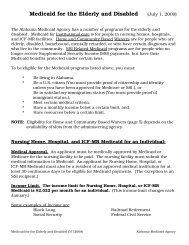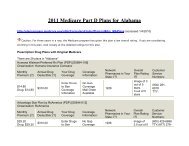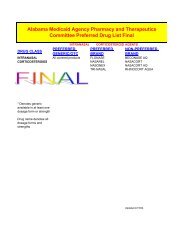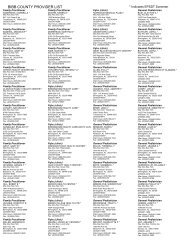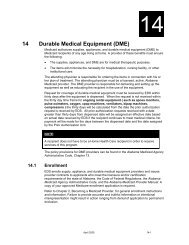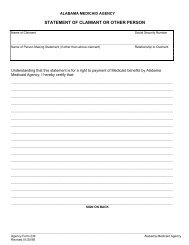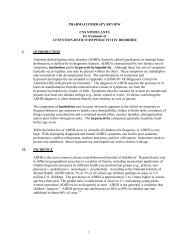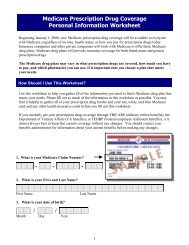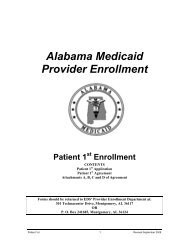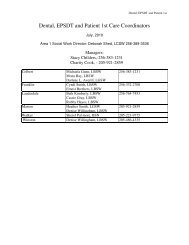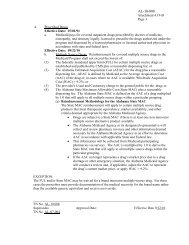6.7.1.1_Jan11_32 - Alabama Medicaid Agency
6.7.1.1_Jan11_32 - Alabama Medicaid Agency
6.7.1.1_Jan11_32 - Alabama Medicaid Agency
Create successful ePaper yourself
Turn your PDF publications into a flip-book with our unique Google optimized e-Paper software.
<strong>32</strong><strong>32</strong> Provider-Based Rural Health ClinicsRural health clinics are defined as clinics located in a rural area designated bythe Bureau of Census as non-urbanized and medically under-served. Ruralhealth clinics are designed to meet the needs of those recipients who mightotherwise be unable to access medical attention.Provider based rural health clinics are clinics that are an integral part ofhospital, home health agency, or nursing facility. Provider-based rural healthclinics are reimbursed on an encounter rate for services provided to <strong>Medicaid</strong>recipients.Refer to the following chapters of the <strong>Alabama</strong> <strong>Medicaid</strong> <strong>Agency</strong>Administrative Code:Chapter 59 for policy for provider-based rural health clinicsChapter 60 for reimbursement policy<strong>32</strong>.1 EnrollmentHP enrolls rural health clinic providers and issues provider contracts toapplicants who meet the licensure and/or certification requirements of the stateof <strong>Alabama</strong>, the Code of Federal Regulations, the <strong>Alabama</strong> <strong>Medicaid</strong> <strong>Agency</strong>Administrative Code, and the <strong>Alabama</strong> <strong>Medicaid</strong> Provider Manual.Refer to Chapter 2, Becoming a <strong>Medicaid</strong> Provider, for general enrollmentinstructions and information. Failure to provide accurate and truthfulinformation or intentional misrepresentation might result in action ranging fromdenial of application to permanent exclusion.National Provider Identifier, Type, and SpecialtyA provider who contracts with <strong>Medicaid</strong> as a rural health clinic provider isadded to the <strong>Medicaid</strong> system with the National Provider Identifiers provided atthe time application is made. Appropriate provider specialty codes areassigned to enable the provider to submit requests and receivereimbursements for claims.NOTE:The 10-digit NPI is required when filing a claim.Rural health clinics are assigned a provider type of 58 and valid specialty is185.January 2011 <strong>32</strong>-1
Provider-Based Rural Health ClinicsNOTE:Physicians affiliated with rural health clinics are enrolled with their ownNPI, which links them to the clinic. The provider type for the physician is 58(Rural Health Clinic). The valid specialties are any of those specialtiesvalid for physicians. Please refer to Chapter 28, Physician, for a listing ofvalid specialties.All other personnel affiliated with the rural health clinic, such as physicianassistants or nurse practitioners, bill using the clinic NPI, and are notassigned individual NPIs.Enrollment Policy for Provider-Based Rural Health ClinicsIn order to participate in the Title XIX (<strong>Medicaid</strong>) Program, and to receive<strong>Medicaid</strong> payment, a provider-based rural health clinic must:Receive certification for participation in the Title XVIII (Medicare) ProgramObtain certification by the appropriate State survey agencyComply with the Clinical Laboratory Improvement Amendment (CLIA)testing for all laboratory sites Operate in accordance with applicable federal, state and local laws.All clinics must enroll separately and execute a separate provider contract with<strong>Alabama</strong> <strong>Medicaid</strong>.The effective date of enrollment of a provider-based rural health clinic will bethe date of Medicare certification. Providers who request enrollment more than120 days after certification are enrolled on the first day of the month theenrollment is approved.The provider based rural health clinic must be under the medical direction of aphysician. The physician must be physically present at the clinic for sufficientperiods of time to provide medical care services, consultation, and supervisionin accordance with Medicare regulations for rural health clinics. A sufficientperiod is defined as follows:No less than once every 72 hours for non-remote sites At least once every seven days for remote sitesRemote sites are defined as those more than 30 miles from the primarysupervising physician’s principal practice location.This requirement must be accommodated except in extraordinarycircumstances. The clinic must fully document any extraordinarycircumstances that prevent it from meeting this requirement.When not physically present, the physician must be available at all timesthrough direct telecommunication for consultation, assistance with medicalemergencies or patient referral.<strong>32</strong>-2 January 2011
Provider-Based Rural Health Clinics <strong>32</strong>Change of Ownership<strong>Medicaid</strong> must be notified within 30 calendar days of the date of a PBRHCownership change. The existing contract is automatically assigned to the newowner, and the new owner is required to execute a new contract with <strong>Medicaid</strong>within 30 calendar days after notification of the change of ownership. If thenew owner fails to execute a contract with <strong>Medicaid</strong> within this time period, thecontract shall terminate.The new owner may choose to accept the established reimbursement rate orsubmit a budgeted cost report to the <strong>Medicaid</strong> <strong>Agency</strong> and must submit hischoice in writing to <strong>Medicaid</strong>’s Provider Audit Program within the 30 daytimeframe.Patient 1 st Requirements for Provider-Based Rural Health ClinicsThe clinic must be a licensed federally recognized RHC enrolled in the<strong>Alabama</strong> <strong>Medicaid</strong> Program, who has not been sanctioned.The administrator must sign a clinic PMP agreement that delineatesprogram requirements including, but not limited to, patient management,24-hour coverage, and other program requirements.The RHC and or site must be opened a minimum of 40 hours per weekand the physician must practice at the location of 40 hours per week to beconsidered a Full Time Equivalent (FTE)In order to be considered to carry a caseload, the physician must be aminimum of a Full Time Physician (FTP). If a physician is less than a FTP,a percentage of a total patient caseload will be allowed based on on-siteavailability.The number of physicians and/or mid-levels and their FTP status willdetermine caseloads. FTP physicians may have a maximum caseload of1200 patients. Mid-level participation will allow a caseload to be extended by 400additional patients. Only two mid-levels per physician will be allowed and amid-level may only be counted once in a caseload extension. If the clinic issolely run by mid-level practitioners, then the FTP equivalent of those midlevelpersonnel will be applied against the 1200 maximum caseload.The RHC must specify what arrangements have been made for hospitaladmissions. If physicians within the RHC do not have admitting privileges,then the designee must be specified. If the RHC/physician does not have adesignee, then the enrollment form must contain documentation as to whatis done to arrange these services for non-Patient 1 st enrollees including awritten statement from the hospital.All physicians and mid-levels practicing in the clinic and their FTP statuswhich are to be considered for purposes of the Patient 1 st Program shouldbe listed on the enrollment form.January 2011 <strong>32</strong>-3
Provider-Based Rural Health Clinics<strong>32</strong>.2 Benefits and LimitationsThis section describes program-specific benefits and limitations. Refer toChapter 3, Verifying Recipient Eligibility, for general benefit information andlimitations.<strong>32</strong>.2.1 Covered ServicesRural health clinic visits and inpatient physician services are subject to thesame routine benefit limitations as for physicians. Refer to the <strong>Alabama</strong><strong>Medicaid</strong> <strong>Agency</strong> Administrative Code, Chapter 6, for details.The following services are covered in the provider-based rural health clinic:Medically necessary diagnostic and therapeutic services and supplies thatare an incident to such services or as an incident to a physician’s serviceand that are commonly furnished in a physician’s office or a physician’shome visit.Basic laboratory services essential to the immediate diagnosis andtreatment of the patient that must include but are not limited to thefollowing six tests that must be provided directly by the rural health clinic:Chemical examinations of urine by stick or tablet methods or both(including urine ketones)Hemoglobin or hematocritBlood glucoseExamination of stool specimens for occult bloodPregnancy testsPrimary culturing for transmittal to a certified laboratoryMedical emergency procedures as a first response to life threateninginjuries and acute illness.Provider based rural health services may be provided by any of thefollowing individuals:Physician Physician assistant, nurse practitioner, certified nurse midwife, orregistered nurseThe physician, physician assistant, nurse practitioner, certified nurse midwife,or registered nurse must conform to all state requirements regarding the scopeor conditions of their practice.The CRNP can make physician-required visits to nursing facilities. However, aCRNP can not make physician required inpatient visits to hospitals or otherinstitutional settings to qualify for payment to the physician or to satisfy currentregulations as physician visits. The PA or CRNP may provide low complexityor straightforward medical decision-making services in the emergencydepartment or assist at surgery (identified surgical codes only) for <strong>Medicaid</strong>reimbursement.<strong>32</strong>-4 January 2011
Provider-Based Rural Health Clinics <strong>32</strong><strong>32</strong>.4 Cost Sharing (Copayment)The copayment amount is $1.00 per visit including crossovers. The copaymentdoes not apply to services provided for pregnant women, nursing facilityresidents, recipients less than 18 years of age, emergencies, and familyplanning.Providers may not deny services to any eligible <strong>Medicaid</strong> recipient because ofthe recipient’s inability to pay the cost-sharing (copayment) amount imposed.NOTE:<strong>Medicaid</strong> copayment is NOT a third party resource. Do not recordcopayment on the CMS-1500 claim form.Medicare Deductible and CoinsuranceFor provider-based rural health clinic services, <strong>Medicaid</strong> pays the Medicaredeductible and coinsurance up to the encounter rate established by <strong>Medicaid</strong>.<strong>32</strong>.5 Completing the Claim FormTo enhance the effectiveness and efficiency of <strong>Medicaid</strong> processing, providersshould bill <strong>Medicaid</strong> claims electronically.Provider-based rural health clinics that bill <strong>Medicaid</strong> claims electronicallyreceive the following benefits:Quicker claim processing turnaroundImmediate claim correctionEnhanced online adjustment functions Improved access to eligibility informationRefer to Appendix B, Electronic Media Claims Guidelines, for more informationabout electronic filing.NOTE:When filing a claim on paper, a CMS-1500 claim form is required.Medicare-related claims must be filed using the Medical<strong>Medicaid</strong>/Medicare-related Claim Form.This section describes program-specific claims information. Refer toChapter 5, Filing Claims, for general claims filing information andinstructions.<strong>32</strong>.5.1 Time Limit for Filing Claims<strong>Medicaid</strong> requires all claims for provider-based rural health clinics to be filedwithin one year of the date of service. Refer to Section 5.1.5, Filing Limits, formore information regarding timely filing limits and exceptions.January 2011 <strong>32</strong>-7
Provider-Based Rural Health Clinics<strong>32</strong>.5.2 Diagnosis CodesThe International Classification of Diseases - 9th Revision - ClinicalModification (ICD-9-CM) manual lists required diagnosis codes. Thesemanuals may be obtained by contacting the American Medical Association,P.O. Box 10950, Chicago, IL 60610.NOTE:ICD-9 diagnosis codes must be listed to the highest number of digitspossible (3, 4, or 5 digits). Do not use decimal points in the diagnosis codefield.<strong>32</strong>.5.3 Procedure Codes and ModifiersNOTE:Provider based rural health provider should refer to Chapter 28, Physician,for procedure code information.NOTE:Providers should use procedure code 36415-90 for routine venipuncturecollection, 36416-90 for collection of capillary blood specimen (eg, finger,heel, or ear stick) and Q0091-90 for collection of Pap smear specimen.Collection of laboratory specimens may be billed only when sendingspecimens to another site for analysis if the other site is not owned, operated,or financially associated with the site in which the specimen was collected.The collection fee may not be billed if the lab work is done at the same sitewhere the specimen was collected or in a lab owned, operated, or financiallyassociated with the site in which the specimen was collected.Independent laboratory providers will not be paid for and should not submitclaims for laboratory work done for them by other independent laboratories orby hospital laboratories.Providers may submit claims for laboratory work done by them in their ownlaboratory facilities. Providers who send specimens to another independentlaboratory for analysis may bill a collection fee. This fee shall not be paid toany provider who has not actually extracted the specimen from the patient.Vaccines For Children (VFC)Refer to Appendix A, EPSDT, for procedure codes for VFC.Preventive HealthProcedure Code DescriptionS9445Prenatal Education (limited to 12 classes per recipient within2-year period)99412 Adolescent Pregnancy Prevention Education<strong>32</strong>-8 January 2011
Provider-Based Rural Health Clinics <strong>32</strong><strong>32</strong>.5.4 Place of Service CodesThe following place of service codes apply when filing claims for providerbasedrural health clinics:POS Code Description11 Office21 Inpatient Hospital22 Outpatient Hospital23 Emergency Room – Hospital31 Skilled Nursing Facility or Nursing Facility<strong>32</strong> Nursing Facility<strong>32</strong>.5.5 Required AttachmentsTo enhance the effectiveness and efficiency of <strong>Medicaid</strong> processing, yourattachments should be limited to the following circumstances: Claims With Third Party DenialsRefer to Section 5.7, Required Attachments, for more information onattachments.<strong>32</strong>.6 For More InformationThis section contains a cross-reference to other relevant sections in themanual.ResourceWhere to Find ItCMS-1500 Claim Filing Instructions Section 5.2Medical <strong>Medicaid</strong>/Medicare-related Claim Filing Section 5.6.1InstructionsEPSDTAppendix AElectronic Media Claims (EMC) Submission Appendix BGuidelinesFamily PlanningAppendix CAVRS Quick Reference GuideAppendix L<strong>Alabama</strong> <strong>Medicaid</strong> Contact InformationAppendix NJanuary 2011 <strong>32</strong>-9
Provider-Based Rural Health ClinicsThis page is intentionally left blank.<strong>32</strong>-10 January 2011



